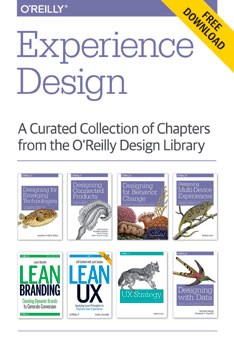Editor’s note: This is an excerpt from our recent book Designing Multi-Device Experiences, by Michal Levin. This excerpt is included in our curated collection of chapters from the O’Reilly Design library. Download a free copy of the Experience Design ebook here.

Download a free copy of the Experience Design ebook here.
Consider the hours we spend with devices every day — interacting with our smartphones, working on our laptops, engaging with our tablets, watching shows on television, playing with our video game consoles, and tracking steps on our fitness wristbands. For many of us, the following are true:
- We spend more time interacting with devices than with people.
- We often interact with more than one device at a time.
The number of connected devices has officially exceeded the seven-billion mark, outnumbering people (and toothbrushes) on the planet. By 2020, this number is expected to pass 24 billion. This inconceivable quantity not only attests to the growing role of these devices in our digital lives, but also signals an increasing number of devices per person. Many individuals now own multiple connected devices — PCs, smartphones, tablets, TVs, and more — and they are already using them together, switching between them, in order to accomplish their goals. Ninety percent of consumers use multiple devices to complete a task over time (PDF). For example, shopping for an item might entail (1) searching and exploring options at home on the PC, (2) checking product information and comparing prices in-store using your smartphone, and (3) writing product reviews on a tablet. Eighty-six percent of consumers use their smartphones while engaging with other devices and during other media consumption activities.
While each device plays an important role in many of our daily activities, their real power exists in how they are used together with other devices. This multi-device usage sets the foundation for a product ecosystem.
The concept of an ecosystem
Biologists use the term ecosystem to describe interconnections within our natural world — a community of living organisms (plants, animals, and microbes) in conjunction with the nonliving components of their environment (elements like air, water, and mineral soil), interacting as a system. An ecosystem essentially describes a network of interactions — among organisms, and between those organisms and their environment — which together create an ecology that is greater than the sum of its parts.
In looking at the world of online apps and electronics today, we can see a type of ecosystem emerging. In this system — this climate of multiple devices — we see smartphones, tablets, laptops, TVs, and other connected devices all interacting with one another and wirelessly sharing data. These interactions are shaped by the different ways in which individuals use the content and services that flow between devices, in different contexts, en route to their goals.
The growing number of connected devices, especially mobile ones, is progressively changing the way people perceive, experience, and interact with products and each other. Our mission as designers and product creators is to understand the different relationships between connected devices, as well as how individuals relate to them, in order to create natural, fluid multi-device experiences that allow these dynamic changes. These experiences should focus on how the (increasing) set of connected devices can best serve users’ needs as they move between activities and contexts throughout the day.
You can choose to build your product as an isolated cell on each device, replicating the same basic experience, and thus offering independent access to everything, everywhere, anytime. Or you can foster an ecosystem approach that captures the dynamically changing needs and contexts that accompany shifting devices, putting the emphasis on delivering the right thing at the right place at the right time.
The latter — the context-driven approach — is where I believe we’ll find our biggest opportunities.
